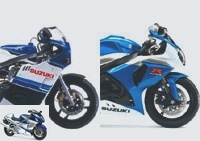Suzuki GSX-R: the myth celebrates its 25 years !

Suzuki celebrates the 25th anniversary of its prestigious line of GSX-R, initiated in 1985 with the revolutionary 750 and followed by many variations. Flashback to the GSX-R saga, Hamamatsu’s most iconic motorcycle !
1986-1997: from the monstrous GSX-R 1100 to the 600 cc scythe
From the year following the launch of its 750, Suzuki realizes the extent of the phenomenon and decides to decline its GSX-R range in several displacements..
From the extremely rare GSX-R 50 to the GSX-R 1300 Hayabusa, including the GSX-R 250, 400, 600, 1000 and 1100, there will be something for everyone, although the three smallest displacements were rarely – if at all – imported into France. As for the Hayab ‘, although unclassifiable, it belongs rather to the sports GT segment (read our).
In 1986, therefore, Suzuki thoroughly reviewed the dynamic behavior of the pioneer of the genre (longer swingarm, firmer suspensions, etc.) and launched the devilish GSX-R 1100! If the 750 wanted to be powerful and light, the 1100 disorientates with its big "4-legged" claiming 130 hp! Lightened – but not really calm! – in 1989, the 1100 received a new frame, a cartridge fork, an adjustable shock absorber and dropped back below the 250 kg mark all full.
Nicknamed "the widowmaker", the GSX-R 1100 is none other than the motorcycle used by the famous – and controversial – Prince Noir to complete the circuit of the Paris ring road in less than … eleven minutes !
Abandoned in 1998, the GSX-R 1100 has attracted many thrill seekers – very! – strong, while the 750 has continued to improve over time: coveted by Kawasaki, Honda and Yamaha, the hegemony of the "Gex" is threatened and Suzuki engineers must regularly make important technical and aesthetic changes to keep it at the top of the bill.
In 1990, Suzuki reacted brilliantly with a lighter 750 and above all more present at low and medium revs, thanks to a race revised upwards (a hallmark of the GSX-R). The bike quickly carves out a flattering reputation, especially since it features a new inverted fork and a plastic sweating the race !
After the adoption of liquid cooling in 1992, the GSX-R 750 took another leap forward in 1996 with the now famous SRAD ("Suzuki Ram Air Direct") forced air intake system which supplied the engine with air. fresh under pressure to increase performance! Each 39mm carburetor additionally features a semi-flat, electronically controlled secondary air path to improve the feel of the throttle grip.
The damping is also making great progress and above all offers preload, rebound and compression settings straight from the Suzuki RGV Grand Prix.
At the end of the 90s, to adapt to the changes in physiognomy of many sporting events, Suzuki unveils the GSX-R 600, the youngest of the family, totally inspired by the 750 of 1996.
Titled Supersport world champion in the hands of the brilliant Stephane Chambon in 1999, the 600 cc is characterized by an certainly angry engine, but a bit hollow in the face of increasingly sharp rivals…
In 2001, the "small" Gex displays seriously downward measurements (163 kg dry, 1,400 mm wheelbase) and delivers 115 hp at 13,000 rpm! Retaining the lines and technical specificities of the 750, the GSX-R 600 continues to align an ever more salivating weight / power ratio, but its current lack of success in the Supersport world championship suggests an imminent redesign inspired by the last vintage of the "queen" of the saga: the dreaded – and dreaded! – GSX-R 1000…
Related articles
-
Suzuki GSX-R: the myth celebrates its 25 years ! Suzuki celebrates the 25th anniversary of its prestigious line of GSX-R, initiated in 1985 with the…
-
Suzuki GSX-R: the myth celebrates its 25 years ! Suzuki celebrates the 25th anniversary of its prestigious line of GSX-R, initiated in 1985 with the…
-
Suzuki Group celebrates 100 years and Yamaha Motor turns 65 Two Japanese manufacturers pass an important milestone in 2020: Suzuki becomes 100 years old…
-
Culture – The Ninja saga celebrates 25 years! – At the origins of the Ninja myth …
The Ninja saga celebrates 25 years ! In 25 years of career, Kawasaki Ninja sports cars have largely contributed to forging this reputation for…
-
News – Motorcycle news 2013: Suzuki celebrates one million GSX-Rs – Used SUZUKI
Motorcycle News 2013 : Suzuki celebrates one million GSX-Rs Initiated in 1985 with the legendary GSX-R750 (read our GSX-R Retrospective), the Suzuki…
-
Sporty – Suzuki GSX-R 1000: Gextraordinarily yours! – The myth continues …
Suzuki GSX-R 1000: Gextraordinarily yours ! In 2001, the arrival of the GSX-R 1000 set the hypersports category on fire! Slightly behind in the face of…
-
Presentation of Dirla Suzuki GSX-R 1300 Hayabusa
Presentation of Dirla Suzuki GSX-R 1300 Hayabusa Falk’s fat falcon Content of No, this is not a 1989 GSX-R 1100 that stands out here. But a 2000s Suzuki…
-
Concept comparison Honda CBR 1100 XX Kawasaki ZX-12 R Suzuki GSX-R 1000 Suzuki GSX 1400 Yamaha FZS 1000 Fazer Yamaha FJR 1300 Six bombs The six most…
-
Model history: 25 years of the Suzuki GSX-R 750
Model history: 25 years of the Suzuki GSX-R 750 Cradle of hyper sports Content of 25 years ago the GSX-R 750 revolutionized the motorcycle world , tea…
-
Comparison test MV Agusta F3 800 and Suzuki GSX-R 750
Comparison test MV Agusta F3 800 and Suzuki GSX-R 750 Middle class super sports car from MV Agusta and Suzuki in the test A veritable middle class has…